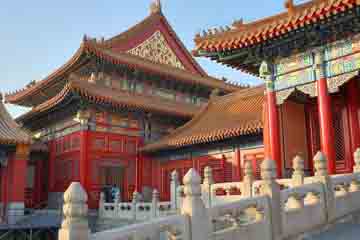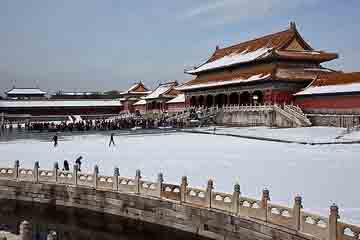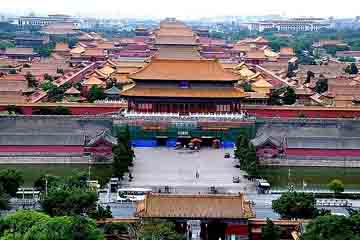Home > Attractions >
The Forbidden City
Located in the heart of Beijing, known as the Forbidden City, is ruins of two generations of imperial palace in Ming and Qing dynasties.The Palace Museum is approached from the south through the Gate of Heavenly Peace (Tian'an men). Ten-meter-high walls and a fifty-two-meter -wide moat surround the palace. Measuring 961 meters from north to south and 753 meters from east to west, the expansive architectural complex covers an area of 1,110,000 square meters. Which is is one of the largest existing and most complete wooden structures in the world and on top of the five world-famous palaces with the Palace of Versailles in France, Buckingham Palace in England, the White House in United States and the Kremlin in Russia.
The Layout of the Palace
The buildings in the Forbidden City are divided into two parts---Outer Court and Inner Court. The southern part of The Palace Museum is Outer Court, features three main halls-the Hall of Supreme Harmony (Taihe Dian), Hall of Central Harmony (Zhonghe Dian), and Hall of Preserving Harmony (Baohe Dian). It is the place where the country holds the grand ceremony. Mirroring this arrangement is the Inner Court, which is the northern portion of the Forbidden City. The Palace of Heavenly Purity (Qianqing Gong), Hall of Union (Jiaotai Dian), and Palace of Earthly Tranquility (Kunning Dong) lie upon the central axis.The Six Eastern Palaces and the Six Western Palaces are private imperial residences found on their respective sides of the main axis. The Inner Court is not only comprised of the residences of the emperor and his consorts but also venues for religious rituals and administrative activities. The far north end of the Inner Court is the Imperial Garden.
Brief Introduction of History
The Ming Dynasty (1368-1644) and the Qing Dynasty (1644-1911) were the last two dynasties in the history of Chinese feudal dynasties. The two dynasties, referring to the imperial palace used by the emperors of the Ming and Qing dynasties, were also synonymous with the highest ruling core of the Ming and Qing dynasties. The palace history of the Ming and Qing dynasties in the past more than 500 years, as a part of the whole history of both dynasties, according to the post-imperial activities, including the hierarchy, power struggle, religious sacrifice, food and clothing and other issues of the study, to show people colorful cruel life image. At the mean time to illustrate the influence of imperator’s politics, words and deeds on the rise and fall of national nationalities and the trend of social life.
Visiting Information
Additional
² CLOSED Mondays (except for national holidays)
² Zhenbao Museum and Zhongbiao Museum separately ticket 10yuan/per.
² Free admission for children under 1.2 meters in height
² Free admission for disabled visitors.
Further details please check on homepage of The Palace Museum: http://www.dpm.org.cn
The Layout of the Palace
The buildings in the Forbidden City are divided into two parts---Outer Court and Inner Court. The southern part of The Palace Museum is Outer Court, features three main halls-the Hall of Supreme Harmony (Taihe Dian), Hall of Central Harmony (Zhonghe Dian), and Hall of Preserving Harmony (Baohe Dian). It is the place where the country holds the grand ceremony. Mirroring this arrangement is the Inner Court, which is the northern portion of the Forbidden City. The Palace of Heavenly Purity (Qianqing Gong), Hall of Union (Jiaotai Dian), and Palace of Earthly Tranquility (Kunning Dong) lie upon the central axis.The Six Eastern Palaces and the Six Western Palaces are private imperial residences found on their respective sides of the main axis. The Inner Court is not only comprised of the residences of the emperor and his consorts but also venues for religious rituals and administrative activities. The far north end of the Inner Court is the Imperial Garden.
Brief Introduction of History
The Ming Dynasty (1368-1644) and the Qing Dynasty (1644-1911) were the last two dynasties in the history of Chinese feudal dynasties. The two dynasties, referring to the imperial palace used by the emperors of the Ming and Qing dynasties, were also synonymous with the highest ruling core of the Ming and Qing dynasties. The palace history of the Ming and Qing dynasties in the past more than 500 years, as a part of the whole history of both dynasties, according to the post-imperial activities, including the hierarchy, power struggle, religious sacrifice, food and clothing and other issues of the study, to show people colorful cruel life image. At the mean time to illustrate the influence of imperator’s politics, words and deeds on the rise and fall of national nationalities and the trend of social life.
Visiting Information
| Peak/Slack Season | Hours | Last Entr | Last Ticket Sold at | Ticket Price |
| Apr. 1st to Oct. 31st | 8:30-17:00 | 16:10 | 16:00 | 60yuan |
| Nov.1st to Mar. 31st | 8:30-16:30 | 15:40 | 15:30 | 40yuan |
Additional
² CLOSED Mondays (except for national holidays)
² Zhenbao Museum and Zhongbiao Museum separately ticket 10yuan/per.
² Free admission for children under 1.2 meters in height
² Free admission for disabled visitors.
Further details please check on homepage of The Palace Museum: http://www.dpm.org.cn






